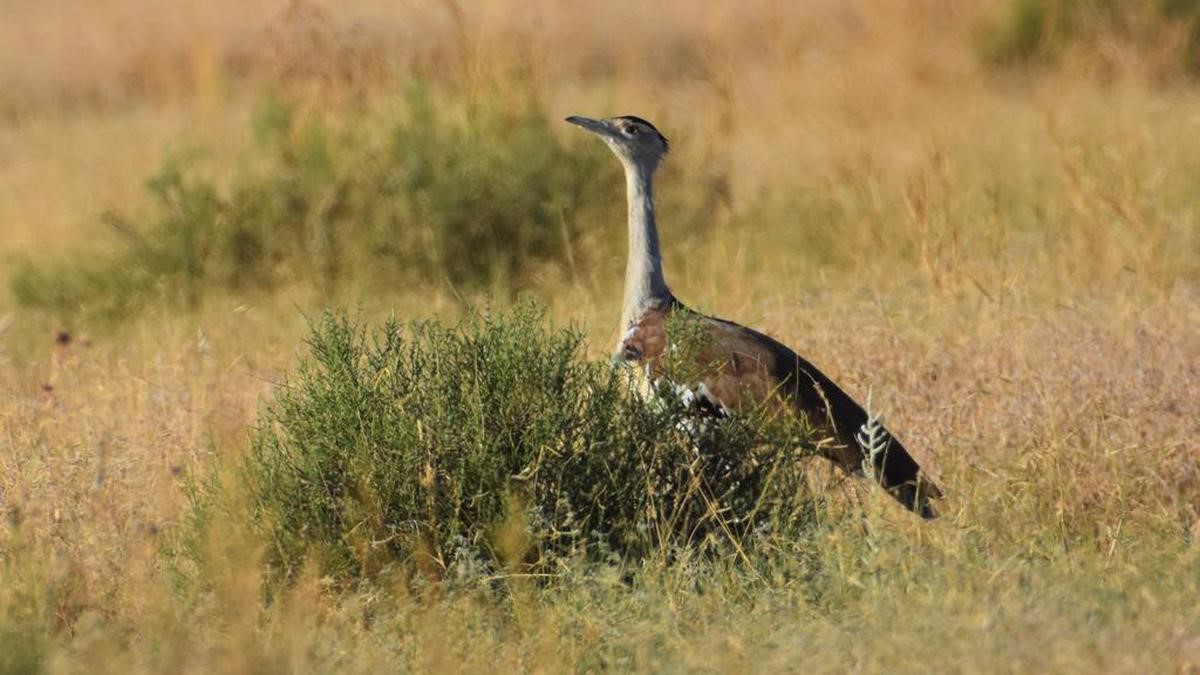Description

Disclaimer: Copyright infringement not intended.
Context: A Supreme Court appointed-committee has recommended that, in order to protect the endangered Great Indian Bustard, close to 800 km, or about 10% of the length of proposed power lines in the Thar and Kutch deserts of Rajasthan and Gujarat should be re-routed or made to go underground.
Details:
Bird conservation vs solar power:
- The deaths of these birds, and the danger to them from power lines and renewable energy projects, triggered a petition in the Supreme Court in 2019, by environmentalists who asked that all overhead lines — existing and prospective — be made to go underground.
- Private and public power companies, supported by the Centre’s Ministry of New and Renewable Energy (MNRE), contended that shifting all overhead lines underground would be expensive and impractical, and would significantly hike the cost of solar power, undermining India’s commitment to green growth.
- The Centre has so far sanctioned the development of solar projects with a capacity of nearly 39,000 MW, but only a fourth have actually been commissioned so far
- In April 2021, the court directed that all low-voltage power lines in areas demarcated as “priority and potential habitats of the Great Indian Bustard” in the Thar and Kutch deserts be pushed underground.
- Priority zones” are areas where the birds are known to live and “potential regions” are those where conservation programmes, such as breeding the birds in captivity, are ongoing.
.jpeg)
Bird diverters: stop-gap solution:
- High-voltage lines in these zones were also expected to follow suit.
- However, if power companies found undergrounding technically infeasible, they could approach a Supreme Court-appointed three-member committee for permission to go ahead with overhead lines with modifications.
- These modifications include installing “bird diverters”, which are flaps installed on power lines that work like reflectors and are visible to the flying birds from about 50 metres away, giving them a chance to swerve out of the path of a power line.
- The Great Indian Bustard is a relatively heavy bird, nearly a metre in height, and with a frontal vision that makes it hard to avoid collisions.
- Low-voltage lines are more likely to electrocute the birds, but they are more likely to die from high-voltage lines due to collisions.
- Bird diverters are, however, considered to be a stop-gap measure, as they cannot entirely guarantee an end to bird hits.
Great Indian Bustard (GIB):
- GIB is one of the most critically threatened speciesin India, with less than 150 birds left in the wild.
- GIBs are one of the heaviest flying birdsin India.
- Experts say only two districts in Rajasthan — Jaisalmer and Barmer— have a breeding GIB population in the wild.
- The bird can also be found in very small numbers in Gujarat, Madhya Pradesh, Karnataka, Maharashtra and Andhra Pradesh.

Steps taken by the Government for protection of Great Indian Bustards in the country:
- A site for establishment of a Conservation Breeding Centre for the Great Indian Bustard has been identified at Kota District, Rajasthan, under the project ‘Habitat Improvement and Conservation Breeding of Great Indian Bustard-an integrated approach’.
- A satellite conservation breeding facilitywith incubator, hatcher, chick rearing and housing for captive birds has been set up at Sam, Jaisalmer, Rajasthan.
- The Great Indian Bustard is listed in Schedule-I of the Wild Life (Protection) Act, 1972,thereby, according it highest degree of legal protection from hunting.
- Important habitats of Great Indian Bustards are designated as National Parks/Sanctuaries for their better protection.
- The species has been identified for conservation efforts under the component ‘Species Recovery Programme’ of the Centrally Sponsored Scheme (CSS)-Development of Wildlife Habitat.
- The Ministry with financial support from National Authority for Compensatory Afforestation Funds has sanctioned an outlay of Rs. 33.85 croresfor the duration of five years for the programme ‘Habitat Improvement and Conservation Breeding of Great Indian Bustard-an integrated approach’ to build up captive population of Great Indian Bustard.
- Ministry has also constituted a Task Force for suggesting Eco- friendly measures to mitigate impacts of power transmission lines and other power transmission infrastructureson wildlife including the Great Indian Bustard.
- The Great Indian Bustard has been included in the Appendix I of Convention on Migratory Species (CMS)of the basis of proposal submitted by India. It was also the mascot of the prestigious 13th CMS Conference of Parties held in Gandhinagar giving wider publicity for the conservation of the species.
MAINS QUESTION:
Q.Conservation of Great Indian Bustard has proved to be a hindrance in India’s march towards solar power. Examine. (150 words, 10 marks)

https://www.thehindu.com/sci-tech/energy-and-environment/sc-committee-directs-10-of-power-lines-in-rajasthan-gujarat-be-altered-to-protect-the-great-indian-bustard/article66470168.ece






.jpeg)











